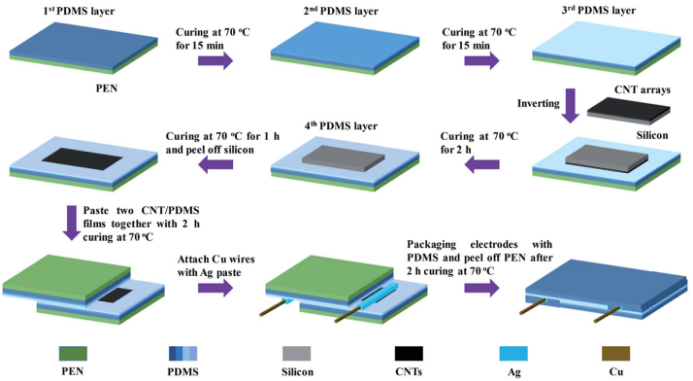Recently, our research group A.P. Zhang Min and XieChao published a study entitled “Sensing-range-tunable pressure sensors realized by self-patterned-spacer design and vertical CNT arrays embedded in PDMS”in RSC ADVANCES, with A.P. Zhang Min as the corresponding author and XieChao as the first author.
A pressure sensor design suitable for a broad sensing range with high sensitivity and good stability is highly desirable for the detection of various pressures and meeting the requirements of different applications.

Herein, we report sensing-range-tunable piezoresistive pressure sensors realized by self-patterned-spacer design. In the sensors, the two CNT-array layers embedded in PDMS are separated by the proposed self-patterned spacer. With this structure, the realized sensors with large initial resistance designed show tunable response thresholds from 300 Pa to 6.5 kPa while maintaining high sensitivity, which are realized by controlling the spacer thickness and the CNT length. Besides, the vertical CNT arrays have a large specific surface area, which can dramatically change the resistance of the pressure sensors and lead to high sensitivity with nearly 50 kPa-1. Benefiting from the designs of the self-patterned spacer and the advantageous combination of CNTs and PDMS, the pressure sensors also exhibit a rapid response/relaxation time of 24/32 ms, and good long-term stability with durability test over 10 000 loading/unloading cycles. On the other hand, the realized pressure sensors with small initial resistance designed show a typical piezoresistive characteristic. For applications, the pressure sensors with large initial resistance designed are suitable for the anti-noise applications with pressure thresholds to filter unnecessary noise and save power consumption, while the pressure sensors with small initial resistance designed show the capability of detecting mechanical forces and monitoring human physiological signals. Moreover, the self-patterned design and fabrication method of the spacers also show potentials to be applied in the existing works to further enhance or adjust the performance of those pressure sensors, showing great flexibility. This design demonstrates great potentials to be applied in future advanced flexible wearable systems such as health monitoring, human–machine interaction and the Internet of Things.